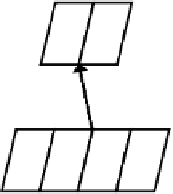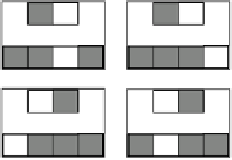Information Technology Reference
In-Depth Information
Output
Event_2
Event_3
Event_0
Event_1
Figure 5.2:
The easy pattern associator task mapping, which
can be thought of as categorizing the first two inputs as “left”
with the left hidden unit, and the next two inputs as “right”
with the right hidden unit.
Input
Figure 5.1:
Pattern associator network, where the task is to
learn a mapping between the input and output units.
Open the project
pat_assoc.proj.gz
in
chapter_5
to begin.
You should see in the network window that there
are 2 output units receiving inputs from 4 input units
through a set of feedforward weights (figure 5.1).
just the weights. This kind of learning has also been la-
beled as
supervised
learning, but we will see that there
are a multitude of ecologically valid sources of such
“supervision” that do not require the constant presence
of a omniscient teacher. The multilayer generalization
of the delta rule is called
backpropagation
, which al-
lows errors occurring in a distant layer to be propagated
backwards to earlier layers, enabling the development
of multiple layers of transformations that make the over-
all task easier to solve.
Although the original, mathematically direct mech-
anism for implementing the backpropagation algorithm
is biologically implausible, a formulation that uses bidi-
rectional activation propagation to communicate error
signals, called
GeneRec
, is consistent with known prop-
erties of LTP/D reviewed in the previous chapter, and is
generally quite compatible with the biology of the cor-
tex. It allows error signals occurring anywhere to affect
learning everywhere.
,
!
Locate the
pat_assoc_ctrl
control panel, press
the
View
button, and select
EVENTS
.
As you can see in the environment window that pops
up (figure 5.2), the input-output relationships to be
learned in this “task” are simply that the leftmost two in-
put units should make the left output unit active, while
the rightmost units should make the right output unit
active. This is a relatively easy task to learn because
the left output unit just has to develop strong weights
to these leftmost units and ignore the ones to the right,
while the right output unit does the opposite. Note that
we use kWTA inhibition within the output layer, with a
,
!
parameter of 1.
The network is trained on this task by simply clamp-
ing both the input and output units to their correspond-
ing values from the events in the environment, and per-
forming CPCA Hebbian learning on the resulting acti-
vations.
5.2
Exploration of Hebbian Task Learning
This exploration is based on a very simple form of task
learning, where a set of 4 input units project to 2 out-
put units. The “task” is specified in terms of the rela-
tionships between patterns of activation over the input
units, and the corresponding desired or
target
values of
the output units. This type of network is often called
a
pattern associator
, because the objective is to asso-
ciate patterns of activity on the input with those on the
output.
Iconify
the
network
window,
and
do
View
,
TEST_GRID_LOG
. Then,
press
Step
in the control
,
!
panel 4 times.
You should see all 4 events from the environment pre-
sented in a random order. At the end of this
epoch
of 4
events, you will see the activations updated in a quick
blur — this is the result of the testing phase, which is
run after every epoch of training. During this testing
phase, all 4 events are presented to the network, except



Search WWH ::

Custom Search